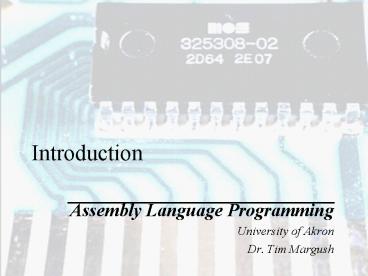Assembly Language Programming - PowerPoint PPT Presentation
1 / 11
Title:
Assembly Language Programming
Description:
... between statements and native machine language ... Each mnemonic used represents a single machine instruction. The assembler performs the translation ... – PowerPoint PPT presentation
Number of Views:222
Avg rating:3.0/5.0
Title: Assembly Language Programming
1
Introduction
- Assembly Language Programming
- University of Akron
- Dr. Tim Margush
2
What Is Assembly Language
- Machine-Specific Programming Language
- one-one correspondence between statements and
native machine language - matches machine instruction set and architecture
- IBM-PC Assembly Language
- refers to 8086, 8088, 80186, 80286, 80386, 80486,
and Pentium Processors
3
What Is An Assembler?
- Systems Level Program
- translates assembly language source code to
machine language - object file - contains machine instructions,
initial data, and information used when loading
the program - listing file - contains a record of the
translation process, line numbers, addresses,
generated code and data, and a symbol table
4
Why Learn Assembly Language?
- Learn how a processor works
- Understand basic computer architecture
- Explore the internal representation of data and
instructions - Gain insight into hardware concepts
- Allows creation of small and efficient programs
- Allows programmers to bypass high-level language
restrictions - Might be necessary to accomplish certain
operations
5
Data Representation
- Binary 0-1
- represents the state of electronic components
used in computer systems - Bit - Binary digit
- Byte - 8 Bits
- smallest addressable memory location (on the
IBM-PC)
- Word - 16 Bits
- Each architecture may define its own wordsize
- Doubleword - 32 Bits
- Quadword - 64 Bits
- Nybble - 4 Bits
6
Numbering Systems
- Binary - Base 2
- 0, 1
- Octal - Base 8
- 0, 1, 2, 7
- Decimal - Base 10
- 0, 1, 2, , 9
- Hexadecimal (Hex)
- 0, 1, , 9, A, B, , F
- Raw Binary format
- All information is coded for internal storage
- Externally, we may choose to express the
information in any numeration system, or in a
decoded form using other symbols
7
Decoding a Byte
- Raw
- 01010000b
- Hex
- 50h
- Octal
- 1208
- Decimal
- 80d
- Machine Instruction
- Push AX
- ASCII Character code
- P
- Integer
- 80 (eighty)
- BCD
- 50 (fifty)
- Custom code ???
8
Machine Language
- A language of numbers, called the Processors
Instruction Set - The set of basic operations a processor can
perform - Each instruction is coded as a number
- Instructions may be one or more bytes
- Every number corresponds to an instruction
9
IBM-PC Instruction Example
- 1011000000000101b or B005h
- OpCode 10110000b
- Copies a byte into AL (a register)
- The byte is found in the second half of the
instruction 00000101b - The Operation Code identifies the type of
instruction and provides some information about
the instruction length
10
Assembly Language vs Machine Language Programming
- Machine Language Programming
- Writing a list of numbers representing the bytes
of machine instructions to be executed and data
constants to be used by the program - Assembly Language Programming
- Using symbolic instructions to represent the raw
data that will form the machine language program
and initial data constants
11
Assembly Language Instructions
- Mnemonics represent Machine Instructions
- Each mnemonic used represents a single machine
instruction - The assembler performs the translation
- Some mnemonics require operands
- Operands provide additional information
- register, constant, address, or variable
- Assembler Directives































